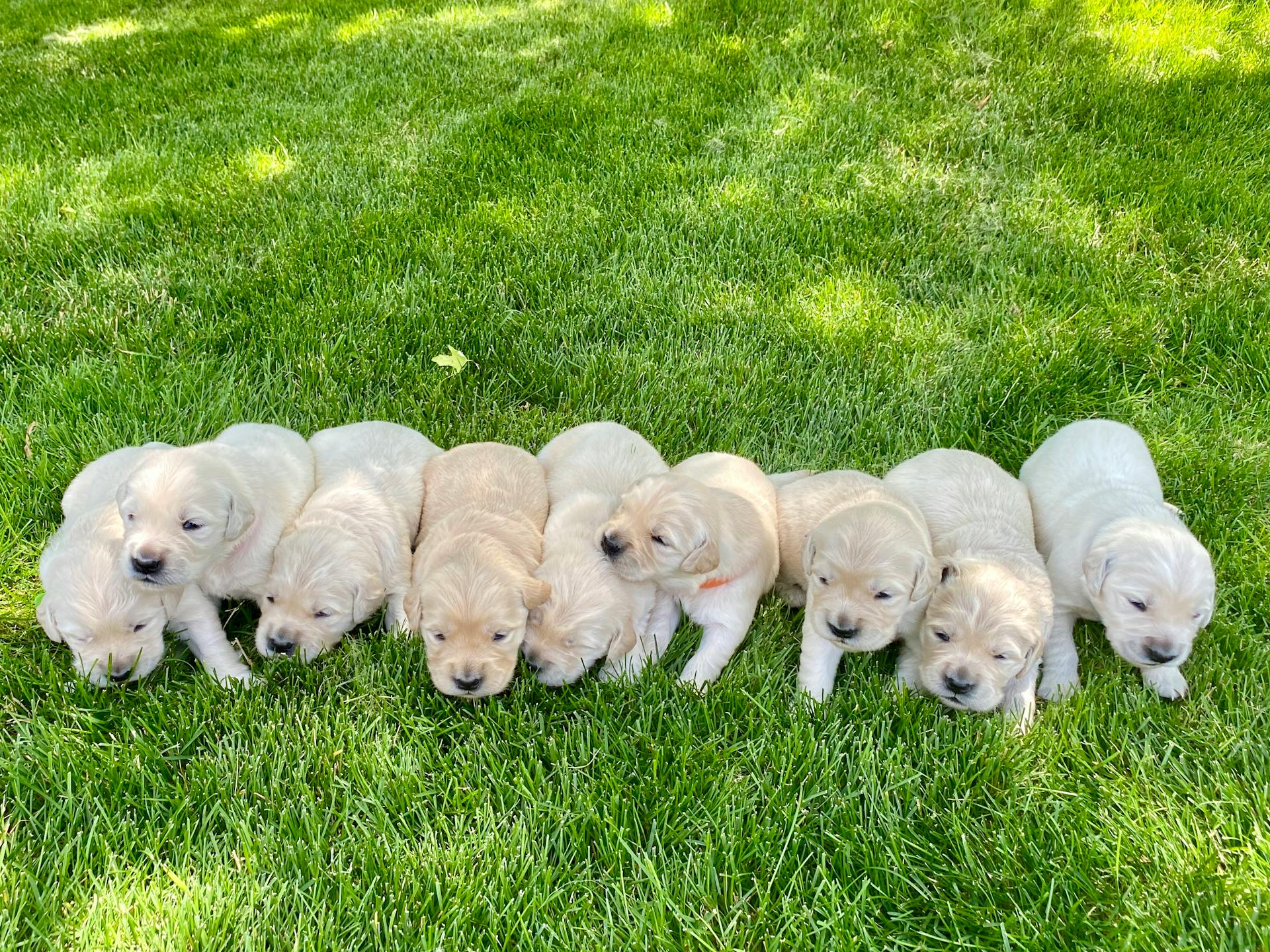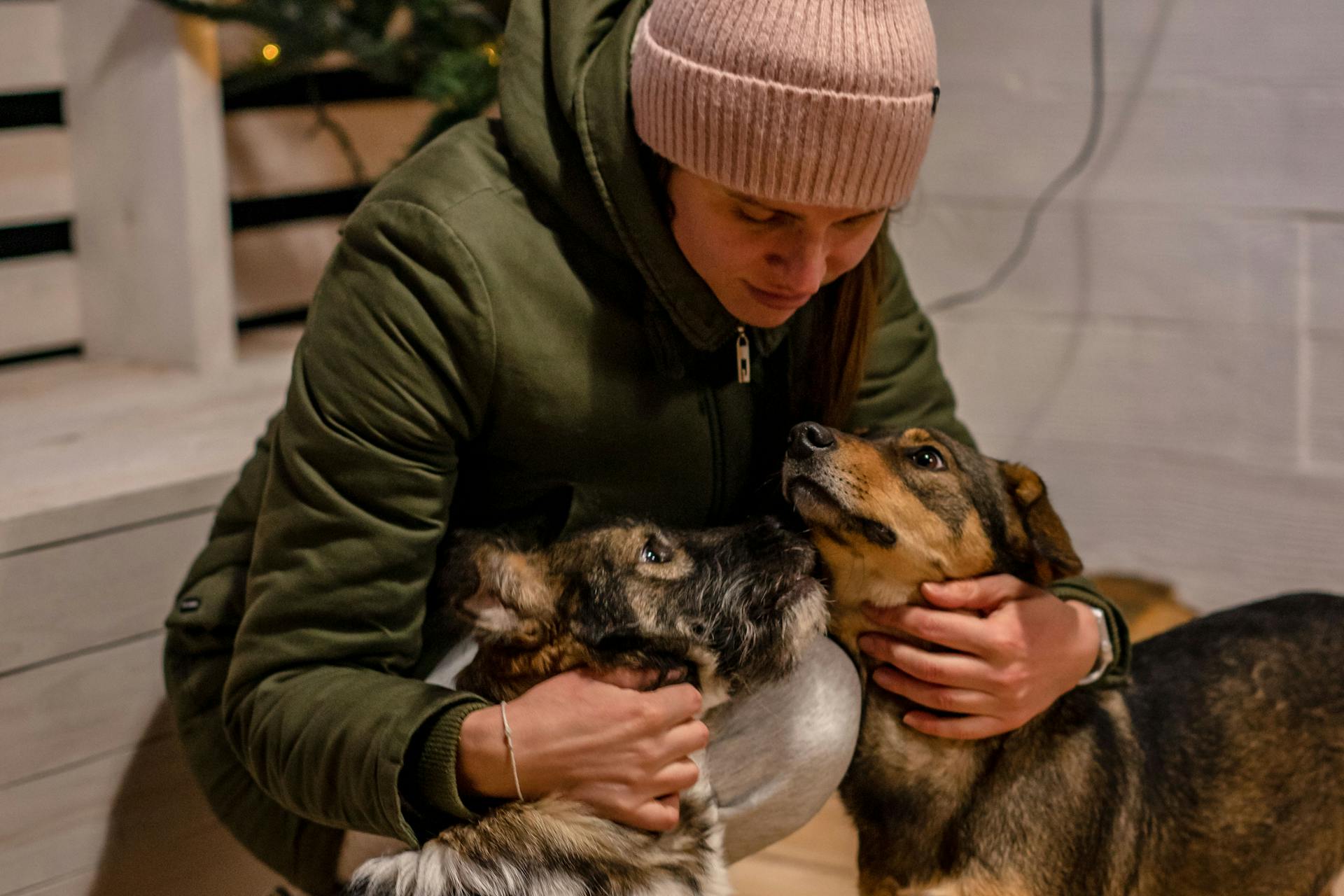
Feeding your dog homemade food can be a great way to ensure they're getting the nutrients they need, but it's essential to get the amount right. According to our research, a good rule of thumb is to feed your dog 2-3% of their body weight in food per day.
This translates to a significant amount of food, especially for larger breeds. For example, a 50-pound dog would need around 1-1.5 pounds of food per day.
To make things easier, it's a good idea to keep a food log to track your dog's intake. This will help you identify patterns and make adjustments as needed.
Intriguing read: What Vitamins Do Dogs Need in Homemade Food
Benefits of Homemade Dog Food
Cooking your dog's food at home can be a game-changer for their health and well-being.
A diet lower in processed foods has been linked with a longer life span in dogs, according to Habib and Becker's research.
Avoiding ultra-processed foods and consuming minimally processed foods can lead to less inflammation in dogs, which may affect both physical and cognitive health.
A Finnish study found that minimally processed, fresh foods can have a similar effect on dogs as they do on humans.
The formulation guidelines for U.S. pet foods are set for highly active animals, which can lead to nutrient deficiencies in less active dogs.
By cooking your dog's food yourself, you have more control over the nutrients to fit their specific lifestyle and needs.
Filardi points out that a more nutritionally sound, home-cooked diet can also significantly affect behavior.
Every time Filardi's clients changed their dog's diet to a more nutritionally sound, home-cooked one, the behavior improved because the dogs were getting what they needed nutritionally.
Worth a look: Food Diet for Dogs
Planning and Preparation
Having the right equipment is essential for preparing homemade dog food. You'll need a food scale, food processor, pots and pans, and containers or bags for portioning the food.
Before you start cooking, make sure you have a clean and safe area in the kitchen to work in. This means keeping foods that may be harmful to your dog out of the way.
It's also a good idea to start small and make smaller quantities of food to begin with. This will allow you to see how your dog does on the diet before committing to making larger batches.
In terms of storage, refrigerated food will stay fresh for three to four days, while frozen dog food is best consumed within two months. Don't feed your dog food that's been in the freezer for more than six months.
What Are Meals?
Meals for your furry friend should be made up of protein, a starch, and fruits and vegetables. The ideal ratio may vary, but Dr. Francisco DiPolo recommends 40 to 50% protein and 25 to 30% complex carbs and/or rice.
Protein sources can be tricky, as some common ones like chicken can be associated with allergies in dogs. Dr. DiPolo suggests using proteins like pork, turkey, fish, or beef, which may be better tolerated.
For another approach, see: Is High Protein Dog Food Good for Dogs

Fruits and vegetables should make up the remaining percentage of your dog's meal, and it's best to start with just one type and gradually add more. Pureed blueberries, mango, or banana are great options, according to Christine Filardi.
Complex carbohydrates like quinoa, barley, or pumpkin are a good choice, as they provide more vitamins and nutritional value. Dr. DiPolo recommends limiting simple carbohydrates like rice.
Omega-3 fatty acids are a crucial ingredient, and Dr. Karen Shaw Becker recommends supplementing with them, even if you're using store-bought food. You can find omega-3s in foods like sardines or use a high-quality fish oil supplement.
What You Need
To make homemade dog food, you'll need a few essential items. First and foremost, you'll want to have a high-quality fish oil or omega-3 supplement on hand, like Nordic Naturals Omega-3 Pet Oil Supplement.
Having a basic kitchen scale is also crucial to ensure your recipes are consistent and you're feeding your pet the proper amount. The OXO Good Grips Stainless Steel Food Scale is a great option.

Batch cooking is a game-changer, and it's recommended to store the food in the freezer until it's ready to thaw. You'll need some food storage containers, like the Reddy Thaw & Store Container For Dogs, to keep everything organized.
If you plan on cooking for multiple pets, you might consider using separate prep supplies to avoid cross-contamination. Some great options include the Reddy Prep Mat And Cutting Board Set For Dogs and the Reddy Double-Sided Spatula For Dogs.
Here's a list of some recommended supplies to get you started:
- Reddy Thaw & Store Container For Dogs
- Winerming Puppy Dog Paw And Bone Silicone Molds
- Reddy Double-Sided Spatula For Dogs
- Reddy Prep Mat And Cutting Board Set For Dogs
- OXO Good Grips Stainless Steel Food Scale
- Nordic Naturals Omega-3 Pet Oil Supplement
- Open Farm Bone Broth
Ingredients Needed
When planning your homemade dog meals, it's essential to have the right ingredients on hand. You'll want to include a mix of protein sources, complex carbohydrates, and healthy fats.
Dr. Francisco DiPolo recommends using protein sources like pork, turkey, fish, or beef, which are easier to find and less likely to cause allergies in dogs. In contrast, chicken is one of the most commonly used proteins and can be a common allergen.
Discover more: Low Protein Food for Dogs Homemade

To add some variety to your dog's meals, Christine Filardi suggests incorporating different fruits and vegetables. Some of her go-to options include pureed blueberries, mango, and banana. You can also try adding ingredients like apple cider vinegar and bone broth for extra nutritional value.
Here are some essential ingredients to keep in your pantry:
- Ground turkey or beef
- Pumpkin or quinoa (complex carbohydrates)
- Vegetables like zucchini, spinach, and carrots
- Fruits like blueberries, mango, and banana
- Omega-3 rich ingredients like sardines or fish oil
Remember to always consult with your veterinarian before making any changes to your dog's diet. They can help you determine the best ingredients and portion sizes for your furry friend.
Tips for Making
Before you start making your dog's food at home, it's essential to have the right equipment and ingredients.
A food scale, food processor, pots and pans, and containers or bags for portioning the food are must-haves. You'll also need a clean area of the kitchen where you can prepare the food without any cross-contamination.
To ensure accuracy, use a food scale to measure out the ingredients. Fresh, high-quality ingredients that are not canned, seasoned, or heavily processed are a must.

You can start by making smaller quantities to see how your dog does on the diet. Many owners choose to prepare food in bulk and refrigerate or freeze it in pre-portioned containers.
If you're not ready to make the leap to cooking all of your dog's food, try adding some real, whole foods to their kibble. You can start with simple additions like scrambled eggs, chopped apples, or carrots.
To give your dog a variety of different nutrients, use different meats, fruits, and vegetables to make your dog's food. However, if your dog has a sensitive stomach, it might be best to stick to one combination that you know works.
Here are some general guidelines for storing homemade dog food:
Rise of Home-Cooking
Home-cooking for dogs has become increasingly popular in recent years, with more pet owners curious about the benefits of homemade pet food. This shift is partly due to dog food delivery services using human-grade ingredients.

Many pet owners are turning to home-cooked food as a solution to help their pets with chronic conditions. For example, pet owners with dogs who have food sensitivities often cook for them.
Research on dog food ingredients has led to a decrease in the global market share of dry food, from 99% a decade ago to 67% today. This change is attributed to humans' increasing wariness of foods made with numerous ingredients and preservatives.
Home-cooked dog meals aren't universally embraced by veterinarians, who have concerns about the lack of unbiased education on alternative pet food categories in vet school nutrition courses.
Choosing a Diet
A homemade dog diet should contain an appropriate balance of protein, carbohydrates, fiber, and fat. This means aiming for at least 10% protein from sources like chicken, turkey, fish, or lean beef.
To ensure your dog gets enough calories, determine their daily caloric need based on their life stage and activity level with the help of your veterinarian. Your veterinarian can also provide guidance on how many calories your dog needs each day.
A balanced homemade dog diet requires adding vitamin and mineral supplements, which can be purchased from reputable companies like BalanceIT.com.
Here's an interesting read: Feed Dog Raw Diet
Allergy Alternatives

Switching to a home-cooked diet can take some time to find the right balance.
Many dogs have individual food preferences, which may affect their eating habits.
At first, you'll need to monitor whether your pup is allergic to certain ingredients.
Proper Nutrition
Choosing a diet for your furry friend can be overwhelming, but it's essential to get it right. Dogs need a balanced diet that meets their nutritional needs, just like humans do.
A homemade dog diet should contain at least 10% protein, which can come from sources like chicken, turkey, fish, or lean beef. You can also use other protein sources like eggs, but in moderation.
Dogs need a balance of protein, carbohydrates, fiber, and fat in their diet. A good starting point is to aim for 40% protein, 50% vegetables, and 10% starch, but this can vary depending on your dog's individual needs.
You should avoid giving your dog high amounts of protein, especially if they're sensitive. Instead, focus on using a variety of protein sources and adjusting the ratios based on your vet's recommendations.
Suggestion: Do Dogs Need Salt in Homemade Food

A well-balanced diet should also include fiber, which can come from vegetables like peas, green beans, and carrots. Aim for about 2.5-4.5% fiber in your dog's diet.
Some good protein sources for your dog include beef, turkey, chicken, lamb, pork, shrimp (fully cooked with shell removed), tuna, and eggs (in moderation). However, be sure to remove excess fat and skin, and watch for poultry bones which can splinter.
If you prefer to feed your dog a mixture of kibble with add-ins, consider using whole eggs, canned cooked salmon, mixed vegetables, cottage cheese or yogurt, and leafy greens like kale or spinach.
Here's a rough guide to help you get started:
Remember, every dog is different, so be sure to consult with your vet to determine the best diet for your furry friend.
Raw
Raw dog food can be a polarizing topic among veterinarians, with some finding it works well for some dogs and not others.
Some touted benefits of a raw meat-based diet include being higher in antioxidants and potentially improving immune function. However, it also presents more risk for the transmission of foodborne pathogens.
Dogs don't have any special ability to get rid of toxins in their body that we don't, according to Dr. Shumaker.
If you decide to feed your pet a raw diet, be careful where you buy your raw meat from, as you don't want to buy from a source that's not specifically designed for canine consumption, like a butcher for canines.
If you're considering raw food delivery services, there are options like Maev Raw Dog Food and We Feed Raw that you may want to consider.
Vegetables and fruits can be given raw, but it's recommended to grate or dice them in small pieces for better digestibility.
Frequently Asked Questions
How much fresh food should I feed my dog?
Feed your dog ½ to 1 cup of food per 10 pounds of body weight daily, considering age, breed, and activity level for a tailored feeding plan
What percentage of ingredients should be in homemade dog food?
For a balanced homemade dog food, aim for a ratio of 40% protein, 30-40% vegetables, and 10-20% starch, ensuring a nutrient-rich diet for your furry friend. Consult a veterinarian or canine nutritionist for personalized guidance on creating a customized recipe.
Sources
- https://www.forbes.com/sites/forbes-personal-shopper/2024/04/26/homemade-dog-food/
- https://www.doggygrub.com.au/blogs/news/cooking-for-your-dog-the-basic-principles
- https://unionlakeveterinaryhospital.com/blog/a-beginners-guide-to-home-cooking-for-dogs
- https://www.thesprucepets.com/homemade-dog-food-recipes-5200240
- https://cleananddelicious.com/homemade-dog-food/
Featured Images: pexels.com


